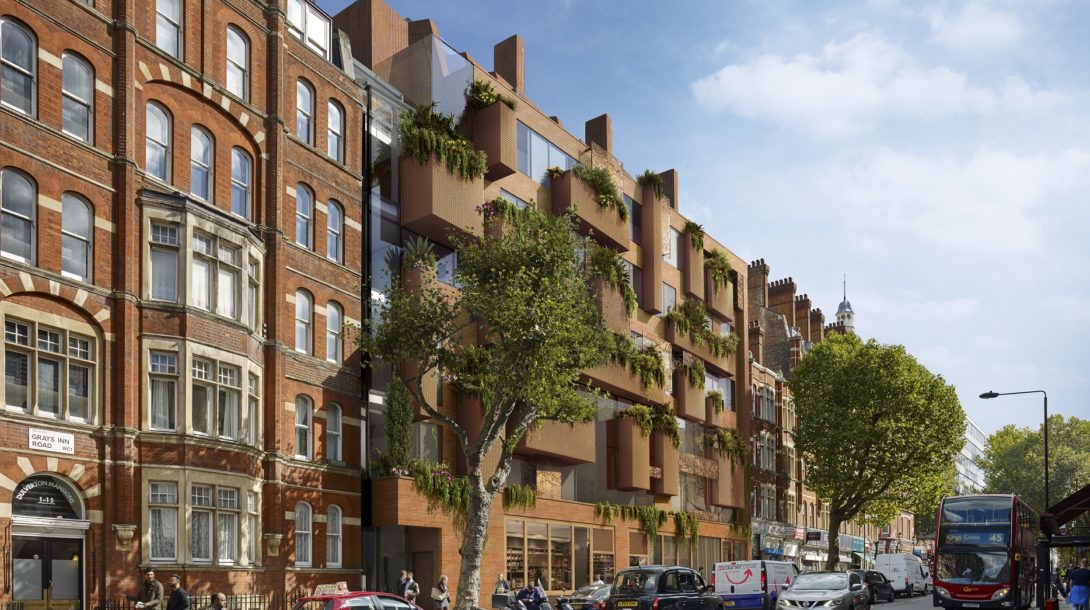Panther House

Panther House is a site with a rich history, it comprises a number of buildings including 38 Mount Pleasant and 156-158 and 160-164 Gray’s Inn Road which were developed in the early 20th century for a mixture of commercial and transport uses. With a lack of investment in the buildings over a number of years, substantial refurbishment or redevelopment of the site was required.
Background
Panther House is a complex of former industrial buildings located between Gray’s Inn Road and Mount Pleasant. A redevelopment scheme had already been approved and our client sought to obtain a new consent for a comprehensive refurbishment and extension which sought to preserve and enhance the existing buildings.
A planning scheme led by development manager Dukelease with architects AHMM was consented at Camden planning committee in 2017 after a protracted application process taking over two years. The proposals included 8000m2 of offices and 15 apartments and retail units behind a retained façade on Gray’s Inn Road. A Section 106 agreement set out a number of pre-demolition, development and construction conditions. To satisfy these conditions would require a significant financial commitment.
Our Role
“A highly unusual façade using biophilia to bring more interest to Gray's Inn road.”
During the years following the resolution to grant consent, and with rising construction costs, the consented development became unviable. Working for the Investment Manager, Funder and new development manager Stone RE, Radcliffes led a design team to develop a new scheme prepared for pre-letting to a co-working tenant. The design was sympathetic to the heritage of the existing buildings, with conservative extensions and infills and a high quality replacement building fronting Gray’s Inn Road incorporating extensive biophilia. The revised scheme was more commercially viable due to lower construction costs without the need for a complex façade retention design. This application was approved at the first remote Committee held by Camden in April 2020, being determined in 8 months from submission.
With two permissions for the same site, it was subsequently sold to a to new investment manager, Credit Suisse, led once again by Dukelease who had a vision to deliver a revised development combining elements of both applications. In order to do so, and to retain certain elements of the first consent, it needed to be implemented in a short timescale.
With two permissions for the same site, it was subsequently sold to a to new investment manager, Credit Suisse, led once again by Dukelease who had a vision to deliver a revised development combining elements of both applications. In order to do so, and to retain certain elements of the first consent, it needed to be implemented in a short timescale.
In April 2020, working closely with the planning consultants Tibbalds and the client stakeholders, Radcliffes co-ordinated the key activities required to implement the consent. The approach to the implementation strategy was openly discussed with local planning officers prior to applications being made and a Post-Planning Performance Agreement (P-PPA) implemented to ensure the submitted conditions discharged expediently.
A series of applications were made as part of the implementation process. This started with a non-material amendment to the first planning application which revised the trigger points for submission of information. This avoided the necessity to complete detailed and technical design, at significant cost prior to the discharge of certain conditions before the commencement of development.
The remaining conditions were then addressed, with the procurement and submission of technical reports (archaeological, geotechnical and structural) and details of the proposed implementation works – the construction of a single ground bearing pile which formed part of the final structural design.
A Lawful Development Certificate (Proposed) or CLOPUD as frequently known, was applied for and granted and following the completion of the piling works a photographic and technical report detailing the piling works completed submitted. A Certificate of Lawfulness of the Existing Use decision (CLEUD) was applied for and then granted in October 2020, which confirmed the implementation of the consent.
Our Impact
In April 2020, working closely with the planning consultants Tibbalds and the client stakeholders, Radcliffes co-ordinated the key activities required to implement the consent. The approach to the implementation strategy was openly discussed with local planning officers prior to applications being made and a Post-Planning Performance Agreement (P-PPA) implemented to ensure the submitted conditions discharged expediently.
A series of applications were made as part of the implementation process. This started with a non-material amendment to the first planning application which revised the trigger points for submission of information. This avoided the necessity to complete detailed and technical design, at significant cost prior to the discharge of certain conditions before the commencement of development.
The remaining conditions were then addressed, with the procurement and submission of technical reports (archaeological, geotechnical and structural) and details of the proposed implementation works – the construction of a single ground bearing pile which formed part of the final structural design.
A Lawful Development Certificate (Proposed) or CLOPUD as frequently known, was applied for and granted and following the completion of the piling works a photographic and technical report detailing the piling works completed submitted. A Certificate of Lawfulness of the Existing Use decision (CLEUD) was applied for and then granted in October 2020, which confirmed the implementation of the consent.
Whilst the process of implementation for a major planning application is not straightforward, there are options available to Developers, Landlords and property owners to revise the conditions of their original planning applications to allow implementation without a requirement for a full commitment to immediately develop and to avoid any reduction in land value. This can assist with those who are looking to sell or simply need more time to appraise and obtain funding.






